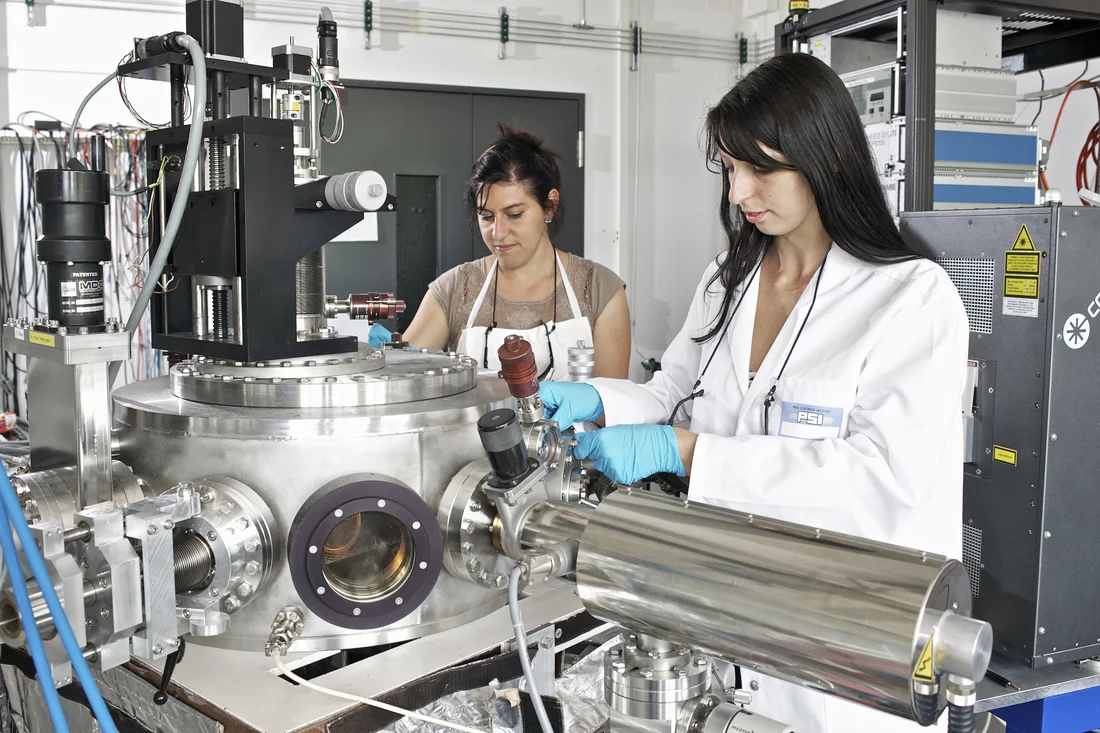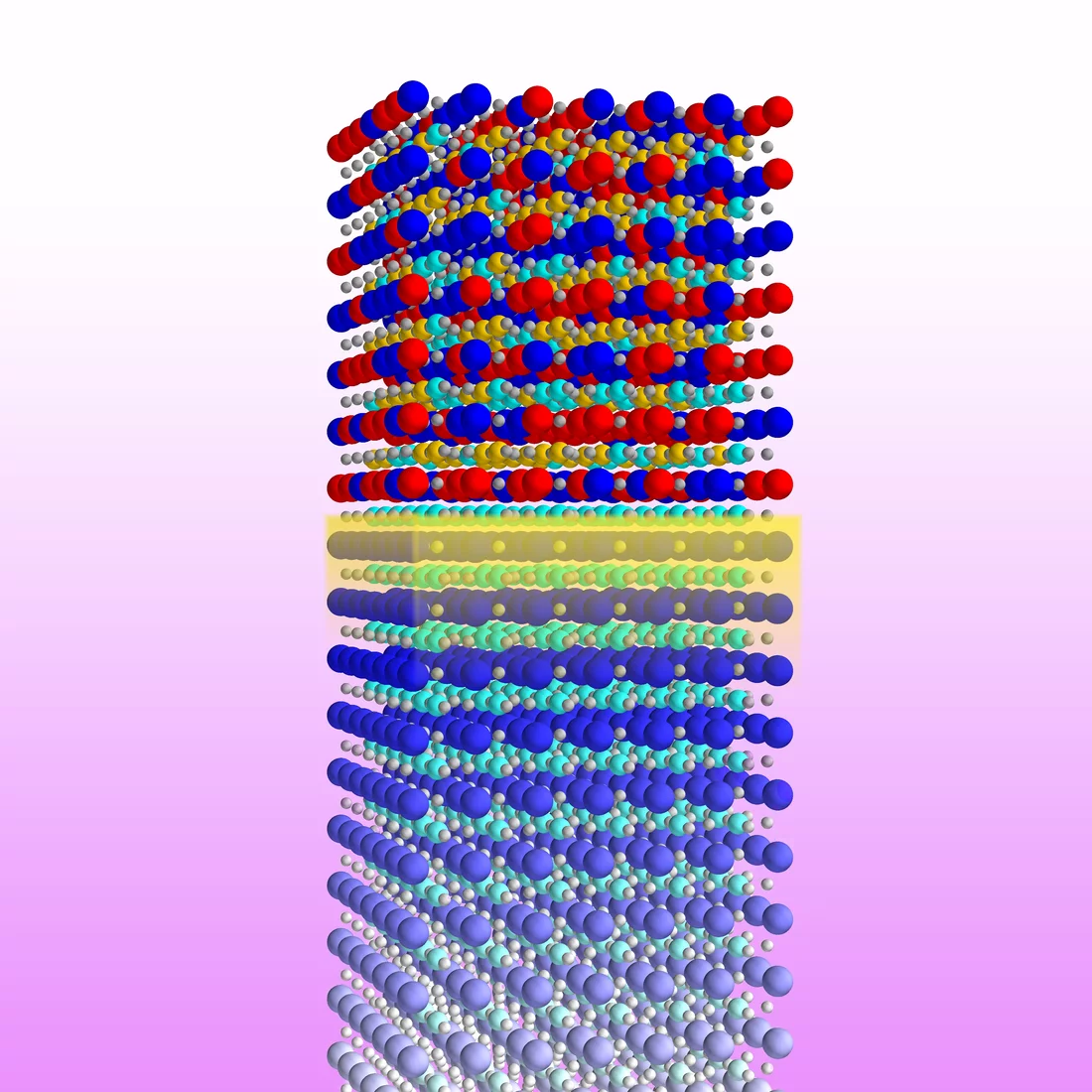How can two materials which do not conduct electricity create an electrically conducting layer when they are joined together? Since this effect was discovered in 2004, researchers have developed various hypotheses to answer this question – each with its own advocates, who defend it and try to prove its validity. Now, an international team under the leadership of researchers at the Paul Scherrer Institute has probably settled the controversy. They have shown that it is the combination of the properties of both materials that produces the effect, and therefore disproved an alternative hypothesis, which proposes that the materials mix at the interface to create a new, conducting material. The materials under study are so-called perovskites, members of a large class of materials with interesting electrical or magnetic properties that could play a significant role in electronics and computing in the future. The results have been published in the scientific journal Nature Communications.
In 2004, researchers discovered something amazing: If the two materials, SrTiO3 and LaAlO3, both of which are electrical insulators, are joined together, a thin, electrically conducting region is formed at their interface. Over the subsequent three years, a number of hypotheses were proposed to explain this effect, which has led to controversy ever since. There are conference sessions at which the majority of contributions are about this effect,
says Mathilde Reinle-Schmitt, a researcher at PSI and the first author of the work presented here. Of the various explanations forwarded, effectively only two competing hypotheses have survived. In order to compare their relative merits, an appropriate experiment was performed by scientists at PSI, together with colleagues from the University of Geneva. In addition, scientists from the University of Liège have contributed important theoretical insights.
Intermixing or polar catastrophe?
Both substances are complex metal-oxide materials – so-called perovskites – with a typical layered structure. In SrTiO3, the structure consists of alternating planes of strontium oxide (SrO) and titanium dioxide (TiO2), while in LaAlO3, they are lanthanum oxide (LaO) and aluminium dioxide (AlO2). The two materials, however, differ in one crucial aspect: In SrTiO3, both planes are electrically neutral, while in LaAlO3 they are alternately positively and negatively charged. The combination of two such materials leads, in the opinion of one school of thought, to the transfer of mobile electrons to the interface between the two materials, thereby making this ultrathin interfacial region conducting. This happens, however, only when the LaAlO3 film is thick enough. Otherwise, the combination of materials remains an insulator. This hypothesis is known as the polar catastrophe
. Other researchers are nevertheless convinced that conductivity is created because both compounds are known to combine at their interface and this intermixed material is conducting.
The appropriate experiment
In order to clarify this controversy, the researchers wanted to answer the question, Is a mixture of the two substances conducting?
Mathilde Reinle-Schmitt says, We used again SrTiO3 as the substrate, but now, instead of depositing pure LaAlO3 on top of this, we used a mixture of SrTiO3 und LaAlO3 in various proportions and thicknesses and then measured the conductivity. The results were surprising. For thin layers of deposited mixtures, the system was insulating, while for thicker layers the interface was conducting, although the layers themselves were not, just as for pure LaAlO3. What changed was that the mixed layer had to be correspondingly thicker the less LaAlO3 there was in the mixture. This result agrees perfectly with the polar catastrophe hypothesis,
says Claudia Cancellieri, PSI scientist and second author of the article. It would be very difficult to explain these results in terms of intermixing.
Numerous applications in view
Perovskites, the category to which the materials being investigated belong, often have interesting electrical and magnetic properties, some of which have never been observed in any other materials. An additional important property is highlighted by Philip Willmott, leader of the investigating group at PSI, In contrast to traditional semiconductors used today, different perovskites have a similar crystalline and chemical structure and can thus be easily incorporated together, so that materials with different characteristics can be combined into a single device, such as a superconductor with a material which reacts sensitively to magnet fields, or one which can detect substances in the air.
Materials in which the current does not flow in all three dimensions, but in only one or, as here, in two, are also current topics of research that could lead to numerous applications.
About PSI
The Paul Scherrer Institute develops, builds and operates large, complex research facilities, and makes them available to the national and international research community. The Institute's own key research priorities are in the investigation of matter and material, energy and the environment; and human health. PSI is Switzerland's largest research institution, with 1500 members of staff and an annual budget of approximately 300 million CHF.
Contact
Prof. Philip Willmott, Laboratory for Synchrotron Radiation – Condensed Matter Physics;Paul Scherrer Institute, 5232 Villigen PSI, Switzerland
Phone: +41 56 310 51 26; E-mail: philip.willmott@psi.ch
Prof. Jean-Marc Triscone, DPMC, Université de Genève
24, quai Ernest-Ansermet, CH-1211 Genève 4
Phone: +41 22 379 66 55; E-mail: Jean-Marc.Triscone@unige.ch;
Prof. Philippe Ghosez, Université de Liège, Institut de Physique, B5a
Allée du 6 août, 17, B-4000 Sart Tilman, Belgium
Phone: +32 43 66 36 11; E-mail: Philippe.Ghosez@ulg.ac.be
Original Publication
Tunable conductivity threshold at polar oxide interfacesM.L. Reinle-Schmitt, C. Cancellieri, D. Li, D. Fontaine, M. Medarde, E. Pomjakushina, C.W. Schneider,
S. Gariglio, Ph. Ghosez, J.-M- Triscone, P.R. Willmott
Nature Communications:
DOI: 10.1038/ncomms1936


